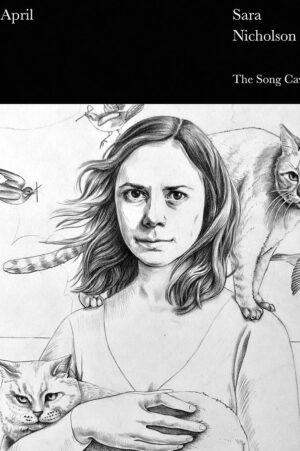April
by Sara Nicholson
reviewed by Michael Martin Shea
April, Sara Nicholson’s third collection, begins with an oblique justification to the reader. In the opening poem, “What I Said, Where I Said It, and Why,” she explains:
To hear myself say it
To listen to myself saying it to you
Who listen, to them or who
Cares why I said it
That I said it for a reason
Or not, to you or not to you.
One can imagine various antecedents for “it”—love, confession, or taboo—but Nicholson never reveals the pivotal phrase, leaving the question open. In its vexed relationship to “you,” its insistence on the pleasure of speech as music, and the space it makes for the wild “or not,” the poem establishes the terms of engagement for the collection. Mostly free of imagistic texture, Nicholson’s opening salvo builds power by letting the argument spiral out without resolution before closing with a meta-poetic turn: “Are there any good poems / About saying it. / If you find one let me know.”
April thus extends Nicholson’s affinity for the coyly rhetorical, already on display in her previous two books. Her newest collection picks up the project of What The Lyric Is (2016), where poetry is characterized as “a record of the attempt / To keep up with the mind. A forest for our / Thoughts to sit in.” Indeed, Nicholson is more interested in the spaces thought can open up than in the content of thought itself.
April contains many of the hallmarks of Nicholson’s verse—wry addresses to the reader, a pastoral orientation hovering at the edge of the ironic, an intermingling of the medieval and the modern, and a fixation on the limits of language, particularly in the face of new media. The latter appears most clearly in “Astrology and the Death Drive,” where she writes:
we await a freer syntax
Than English allows, recycle language
On dying land the astrological
Signs never reference, the pastoral
Of capital, in which flowers and stars
Are likewise monetized
Since the release of her first book, Nicholson has written for readers similarly suspicious of language’s transparency. But in April, the question of language’s denotative capacity is shelved in favor of a general meditation on the nature of art, which drives Nicholson to new territory. “The Archetype” finds the poet engaged in cascading ekphrases, describing various depictions of Zeus’s rape of Leda, name-checking Yeats, and quoting Auden; “The Goatherd and the Saint” places the speaker at the Frick Museum in Manhattan, contemplating the relationship between art and labor while a woman beside her plays Candy Crush.
If these references to the external world feel jarring for a writer once described as “pure hippocampus,” they signal the development of new poetic capacities. Nicholson has never been particularly prolix—her poems are often marked by their pithy humor. But April finds her almost plainspoken, displaying an emotional vulnerability hitherto shrouded under unexpected turns of phrase. As she writes in “Utopia,” “I aim to simplify / my loss, ambition, rage and joy / Into a single word / And speak it to you, Love.”
April makes few universalizing gestures; these are poems for people who know what “Poetryland” refers to, or who appreciate the tongue-in-cheek tone of a poem titled “To The Committee.” At times, Nicholson’s voice even carries an echo of the New York School poets. But April is less concerned with recording a situated dailiness itself than what such a recording can mean, and what it can’t. As she writes in the long prose meditation “Lives of the Saints,” “The odds overwhelmingly favor it: your life is not interesting. Why, then, do you write about yourself?” And later in the same piece, she muses: “Language: the promise of infinite possibility from finite means … And the very best poems, vectors of a numinous energy, … ‘condense eternity.’” It is a vision of poetry wary of abstract nouns, even as abstraction remains the horizon for writing itself, and April is concerned above all with this tantalizing promise of squaring the circle.
Yet as she remarks in “April,” whose title refers as much to National Poetry Month as the tired trope of spring, this search is often a dead end. As she writes, “I sought a theme and sought for it in vain / I’m tired.” This is the impasse Nicholson’s speaker finds herself facing, where “the perfect word / Is hard to find,” particularly if you are “Waylaid by the forms / The sacred takes.” In the book’s longer pieces, her ability to navigate this trap is most fully on display—if the perfect word isn’t to be found, there is at least a forest where it could appear. The collection’s beautiful final poem, “Ten Lyric Pieces,” is one such thicket. Counter to its unassuming title, each numbered segment runs into the next, mashing up traditional lyric content—nightingales and moons—with adjunct work and #MeToo. But in its final moments, the poem becomes a more specific address:
I want a better world for Opal
9.
To grow up in. It takes a lifetime
To grow up, which is another question
It takes growing up to answer:
That time you recognized the drone
Of crickets as a music worthy
Of itself alone
What the question actually is, and what the answer, are ultimately sidelined; the end of rhetoric is this song that “gives more than it takes.” April is most impressive in its commitment to performing the kind of associative, musical thinking that can only be done in a poem, “for a reason / Or not.”
Published on November 7, 2023

